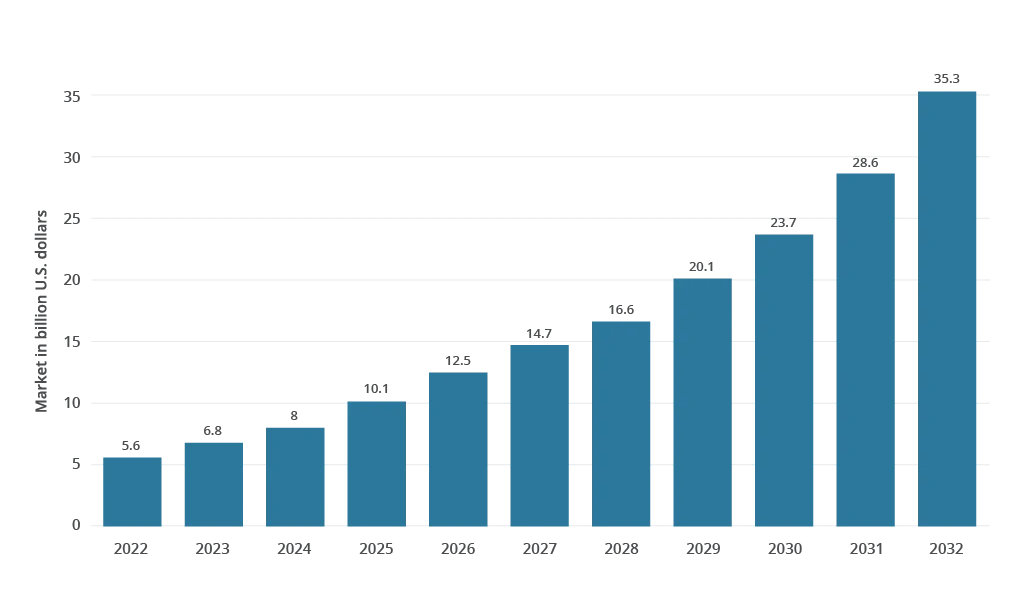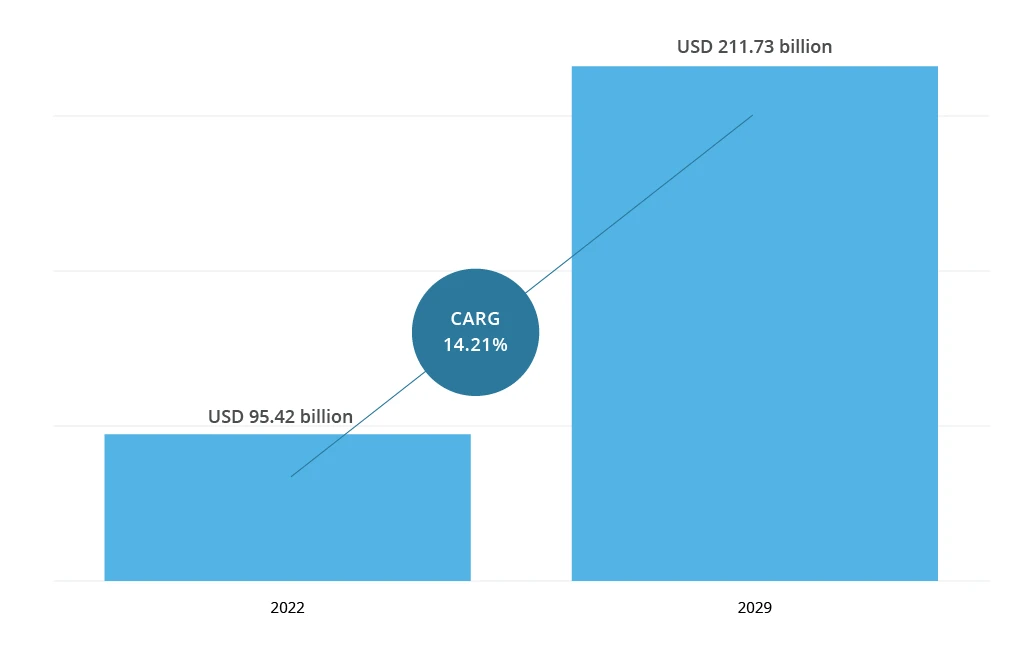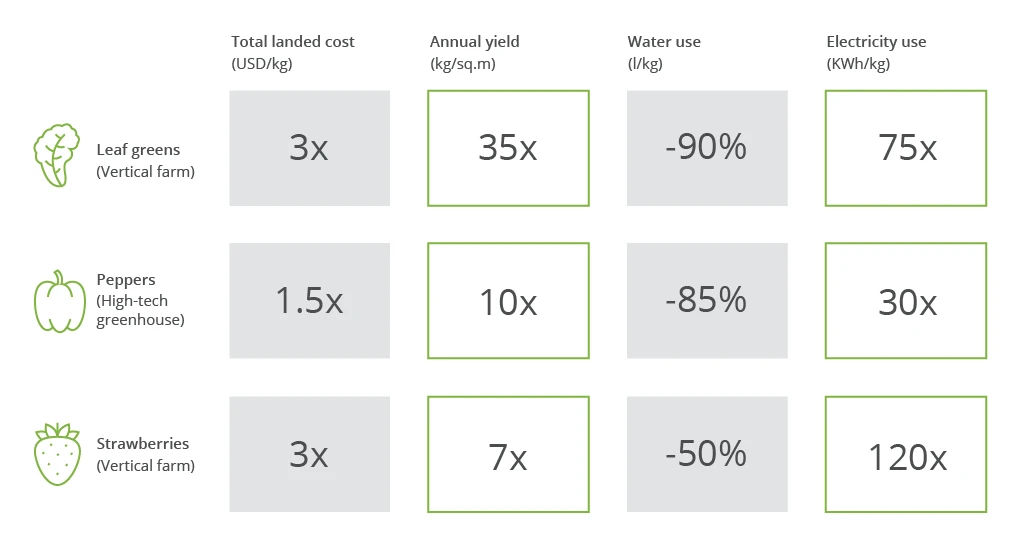What Are the Pros and Cons of the Industrial Scale of Controlled Environment Agriculture?
- Agriculture
- Innovations
- Data & Analytics
- Digital Transformation
- Software Engineering
- Digital Experience
Today, the United Nations warns that the global population is expected to reach 9.7 billion by 2050. CEA's ability to produce food despite weather and geographical limitations can play a crucial role in ensuring food security for a growing population. This technology is a boon for agribusinesses looking to boost efficiency and sustainability, but significant hurdles remain before it can reach its full potential.
What Is Controlled Environment Agriculture (CEA)?
Controlled environment agriculture (CEA) is a method of growing crops indoors or in a protected setting where environmental factors like light, temperature, humidity, gasses concentration, and water and nutrient supply are controlled precisely.
This approach stands in stark contrast to traditional agriculture, which relies on the whims of nature and can be significantly impacted by extreme conditions like droughts, floods, or unexpected frosts. CEA facilities, on the other hand, create perfectly balanced environments for specific crops, allowing for all year-round production. Not only does this level of control only ensure consistent yields but it also enables the cultivation of crops in regions traditionally unsuitable for them.
For the last few years, the industry has had significant investments made in high-tech greenhouse technologies. However, CEA is currently not cost-effective for bulk commodities like grains and legumes and hardly possible for root vegetables, such as potatoes and carrots. The technology excels at producing leafy greens, herbs, certain vegetables, and smaller fruits like strawberries. The price point for CEA products is often higher than traditionally grown options. Having said that, the benefits of environmental sustainability, consistent quality, and local production can justify the premium for certain consumers. In the long run, CEA has the potential to create entirely new categories of food products not previously available, establishing its unique market niche.
Types of Controlled Environment Agriculture Facilities
Controlled environment agriculture encompasses a diverse and growing array of techniques, each offering unique advantages and areas of specialization. Here's a closer look at the prominent players in the CEA landscape:
- Greenhouses. These are enclosed structures that allow for some control over the environment but still rely partially on natural sunlight. Greenhouses are suitable for a variety of crops and require a relatively low initial investment compared to other CEA methods. The commercial greenhouse market is estimated at almost $50 billion in 2024, projected to reach $66.86 billion by 2029. As farmers worldwide seek higher yields and quality production amid shrinking cultivable land and climate fluctuations, the market continues to grow.
- Vertical farms. These multi-layered structures, that maximize space utilization by stacking growing areas vertically, greatly reduce the need for land and construction, and help meet the rising demand for organic food in urban areas. The global vertical farming market has been steadily growing due to urbanization and population increases, with a projected value surpassing $35 billion by 2032.
- Bioreactors. These specialized facilities are designed to cultivate algae, fungi, bacteria, and other biological materials including plant cells or tissues. One of the most common examples is growing chlorella and spirulina algae as food additives. Bioreactors are also used for advanced applications such as producing specific plant compounds or culturing meat alternatives. Initially driven by high demand during the COVID-19 pandemic for vaccine production, the market growth has stabilized, buoyed by technological advancements and increasing applications in pharmaceuticals, tissue engineering, and industrial production.
The State of the CEA Market
The CEA market is experiencing significant growth, driven by several factors. As the cost of setting up CEA facilities decreases and the demand for consistent, reliable food supplies increases, more and more opportunities are emerging for this industry. In 2022, the global CEA market was worth $95.42 billion. By 2029, it's expected to hit nearly $212 billion, with an annual growth rate of 14.21%.
However, the market has also seen its share of challenges. In the aftermath of COVID-19 during 2022-2023, there was a wave of bankruptcies in the vertical farming sector. This can be attributed to the initial rush, where some startups entered the market without a viable product, substantial scientific expertise, or intensive research and development. As a result, many facilities became unprofitable, leading to investor pullout and company closures. According to a survey, most agrifoodtech venture capital investors predict a continued market correction for startup valuations in 2024. Among the 28 leading investors surveyed, 30% foresee tougher times ahead for startups seeking capital, while 44% believe the market has hit its lowest point. At the same time, 11% express optimism, anticipating better times ahead.
This period of market correction can be seen as a positive sign, weeding out unsustainable practices and paving the way for a more established and well-grounded CEA industry. The future belongs to those who will have invested in developing their own technological know-how and scientific understanding.
Benefits of Industrial-Scale CEA
It's essential to recognize that CEA, at least in its current state, serves as a supplement rather than a replacement for outdoor cultivation. To determine the optimal approach for a specific crop and season, producers must weigh potential yields, environmental impacts, and financial implications. Yet, it has its application and advantages to traditional outdoor farming, as highlighted in the EIT Food North-West Regional Office report. Let's now shift our focus to the key benefits provided by CEA.
Predictable Yields, Consistent Quality
Unlike traditional agriculture that depends on weather patterns, CEA offers a controlled environment where every factor influencing plant growth is meticulously managed. Such precision results in consistent harvests with predictable size, taste, and nutrient content. This is a game-changer for businesses with strict quality requirements, such as the pharmaceutical industry that relies on plants for specific medicinal compounds.
A new trend called "harvest design" pushes the boundaries of CEA even further. By manipulating light cycles and nutrient delivery, agro producers can program the final product to have desired levels of vitamins, sugars, or other beneficial compounds. For instance, consider cultivating strawberries with a higher concentration of antioxidants or lettuce with an increased content of vitamins A and K. This tailored approach extends to high-value medicinal plants as well. As an example, cultivators can target specific cannabinoid profiles in cannabis, like increasing the CBD content for therapeutic purposes or influencing the THC level for recreational uses. To sum up, such a high level of customization creates a new niche of "designer" crops with targeted health benefits.
Water Conservation and Reduced Waste
CEA facilities are water misers. Techniques like hydroponics and aeroponics eliminate the need for soil-based agriculture, dramatically reducing water consumption by up to 90%. Moreover, this approach fosters sustainability efforts and waste reduction by recycling and reusing nutrient solutions.
Localization of Production and Fresher Produce
CEA facilities can be located near urban centers, reducing transportation costs, the environmental impact of long-distance produce shipment, and the time it takes for fresh produce to reach consumers. This results in fresher food on grocery store shelves and a smaller carbon footprint for industry.
Minimized Pesticide Use
The controlled environment of CEA facilities minimizes the need for chemical pest and weed control. Not only does this protect consumers from harmful residues but it also safeguards the environment from potential contamination by agricultural runoff.
However, as with every new technology, CEA also comes with its own unique challenges and obstacles on the path to widespread adoption.
Challenges and Difficulties of Industrial-Scale CEA
High Upfront Costs
Setting up and maintaining a large-scale CEA facility requires significant investment into advanced technology for lighting, climate control, and automated systems. Take, for example, the average construction costs for commercial greenhouses, which typically amount to around $270 per square meter ($25 per square foot). For large-scale CEA facilities with more sophisticated technology this cost can be significantly higher.
Energy Consumption
Artificial lighting, climate control systems, and other technologies can be energy-intensive, impacting operational costs and potentially negating the environmental benefits of CEA. Finding renewable energy solutions like solar power or geothermal energy is crucial for the long-term sustainability of this technology.
Technical Expertise
Operating a complex CEA system requires specialized knowledge that goes beyond traditional farming practices. A lack of skilled professionals who can manage these intricate systems and optimize plant growth can hinder the widespread adoption of CEA. A 2022 Control Engineering Career and Salary Survey research highlights the growing demand for engineering specialists, which are the driving force behind the development of the CEA market.
Market Fluctuations
The viability of CEA depends on the market price of the product, where fluctuations can significantly impact profitability. For example, if the selling price for lettuce suddenly drops, a CEA facility producing lettuce may struggle to compete with traditional, lower-cost options. However, careful planning, risk management, and focusing on high-value crops can help mitigate this challenge.
Not a Universal Solution
Designing a CEA system that functions efficiently across diverse climates is a challenge. For instance, optimizing energy usage for heating or cooling becomes a significant hurdle depending on whether a facility is located in a frigid Scandinavian country or a scorching desert climate. A "one size fits all" approach simply won't work, and customization based on location is essential.
On top of that, access to resources can significantly impact CEA feasibility. Limited water availability in certain regions requires investment in water capture and treatment technologies to support hydroponic or aeroponic systems. Reliable and affordable energy is essential for powering climate control systems and lighting, particularly in areas with unstable power grids where backup generators or renewable energy sources may be needed. These factors emphasize the importance of tailoring CEA systems to specific locations and resource availability.
How to Optimize CEA Operations?
Controlled environment agriculture holds immense promise, but maximizing its potential requires a high-tech toolkit. Here's a glimpse into the essential components that empower CEA facilities, along with how they can be implemented:
- Custom software development. CEA relies on complex software to manage a multitude of factors – lighting, water and nutrients supply, climate control, and gasses concentration. Infopulse can develop these sophisticated programs to ensure precise control and efficient resource management. Additionally, we create user-friendly interfaces for remote monitoring and adjustments, granting farmers the flexibility to fine-tune their systems from anywhere.
- Leveraging digital twins. Visualize a perfect digital copy of your entire CEA facility. This digital twin can be used to analyze real-time data from sensors and historical records to predict equipment failures, optimize resource allocation like water and nutrients, and even identify potential problems with temperature or humidity before they impact your crops. By addressing issues like these through the digital twin, you can minimize downtime in your CEA facility and ensure smooth, uninterrupted production cycles.
- Providing firmware updates. Just like a well-maintained machine, a controlled environment agriculture facility relies on consistent updates to function at its best. Firmware updates for the various control systems within your CEA, like lighting and climate controls, are essential for optimal performance. These updates can eliminate software bugs that might disrupt operations and ensure compatibility with the latest hardware and software versions.
- Integrating safety features. Safety is paramount in any controlled environment. Infopulse can develop and integrate safety features into your CEA software. These features can include automated shutdowns in case of sensor malfunctions, environmental parameter deviations, or equipment failures, minimizing potential damage and ensuring the well-being of your plants and personnel.
- Developing reaction scripts. These scripts act like pre-programmed instructions for your control systems. When specific environmental changes occur, like a sudden temperature spike, the script automatically triggers pre-defined actions, such as adjusting ventilation or irrigation. As a result, this automation ensures a swift and precise response to maintain optimal growing conditions for your crop.
To Conclude
While not suitable for all crops, CEA offers a glimpse into the future of agriculture. As technology matures and production costs decrease, we can expect to see a wider variety of crops being grown in CEA facilities. The ability to cultivate "impossible" or difficult-to-grow crops under controlled conditions opens doors for increased food security and dietary diversity.
The success of controlled environment agriculture hinges on a collaborative effort between technology providers like Infopulse, CEA facility operators, researchers, and policymakers. By working together, this industry can overcome challenges, reduce costs, and unlock the potential of CEA to transform our food systems. This collaborative approach holds the key to ensuring a sustainable and secure food supply for generations to come.
![Pros and Cons of CEA [banner]](https://www.infopulse.com/uploads/media/banner-1920x528-industrial-scale-of-controlled-agriEnvironment.webp)





![Agriculture Robotics Trends [Thumbnail]](/uploads/media/thumbnail-280x222-what-agricultural-robotics-trends-you-should-be-adopting-and-why.webp)

![Big Data Use Cases in Agriculture [thumbnail]](/uploads/media/thumbnail-280x222-key-agro-challenges-solved-by-advanced-data-analytics.webp)

![Hyperautomation Complex tasks in Agriculture [Thumbnail]](/uploads/media/thumbnail-280x222-hyperautomation-complex-tasks.webp)

![IoT as the Core of Digital Farming and Agriculture [thumbnail]](/uploads/media/280x222-iot-as-the-core-of-digital-farming-and-agriculture.webp)
![RPA Bots in Agriculture [thumbnail]](/uploads/media/thumbnail-280x222-the-potential-of-RPA-bots-in-agri.webp)